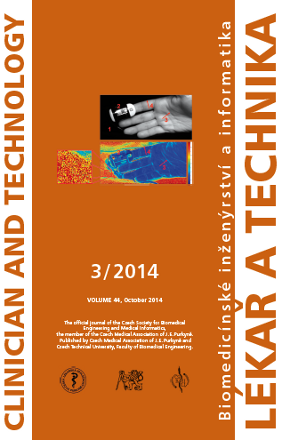VLIV PRŮTOČNÉHO ODPORU DÝCHACÍCH CEST A ALVEOLÁRNÍ PODDAJNOSTI NA DECHOVÝ OBJEM PŘI VYSOKOFREKVENČNÍ OSCILANÍ VENTILACI
Keywords:
high-frequnecy oscillatory ventilation, flow resistance, alveolar compliance, tidal volume, lung modelAbstract
THE EFFECTS OF AIRWAY RESISTANCE AND ALVEOLAR COMPLIANCE UPON DELIVERED TIDAL VOLUME DURING HIGH FREQUENCY OSCILLATORY VENTILATION. Mechanical lung ventilation is used for a delivery of the oxygen into the organism and removal of carbon dioxide from the organism in cases where the spontaneous breathing of the patient is inhibited or insufficient. High-frequency oscillatory ventilation is quite different from conventional regimens of mechanical ventilation. High-frequency oscillatory ventilation is used mainly for the patient with evere acute respiratory distress syndrome, however concrete target group of the patient is not clearly defined. The model of hte lungs according to its morphological description is designed for studying of the high-frequency oscillatory ventilation. The effect of the mechanical properties of the lungs,airway resistance and alveolar compliance upon the delivery of tidal volume is studied for high-frequency oscillatory ventilation. Resistance of the airways significantly affects the tidal volume in high-frequency oscillatory ventilation whereas the effect of the descrease of the alveolar compliance is almost negligible.Downloads
Published
Issue
Section
License
Copyright (c) 2017 Zuzana Rožánková, Martin Rožánek, Marianna Laviola, Petr Kudrna, Karel Roubík

This work is licensed under a Creative Commons Attribution 4.0 International License.
Authors who publish with this journal agree to the following terms:
- Authors retain copyright and grant the journal right of the first publication with the work simultaneously licensed under a Creative Commons Attribution License (https://creativecommons.org/licenses/by/4.0/) that allows others to share the work with an acknowledgment of the work's authorship and initial publication in CTJ.
- Authors are able to enter into separate, additional contractual arrangements for the non-exclusive distribution of the journal’s published version of the work (e.g., post it to an institutional repository or publish it in a book), with an acknowledgment of its initial publication in this journal.
- Authors are permitted and encouraged to post their work online (e.g., in institutional repositories or on their website or ResearchGate) prior to and during the submission process, as it can lead to productive exchanges.
CTJ requires that all of the content of the manuscript has been created by its respective authors or that permission to use a copyrighted material has been obtained by the authors before submitting the manuscript to CTJ. CTJ requires that authors have not used any copyrighted material illegally, as for example a picture from another journal or book, a photo, etc. It is the author’s responsibility to use only materials not violating the copyright law. When in doubt, CTJ may ask the authors to supply the pertinent permission or agreement about the use of a copyrighted material.
The opinions expressed in CTJ articles are those of authors and do not necessarily reflect the views of the publishers or the Czech Society for Biomedical Engineering and Medical Informatics.


